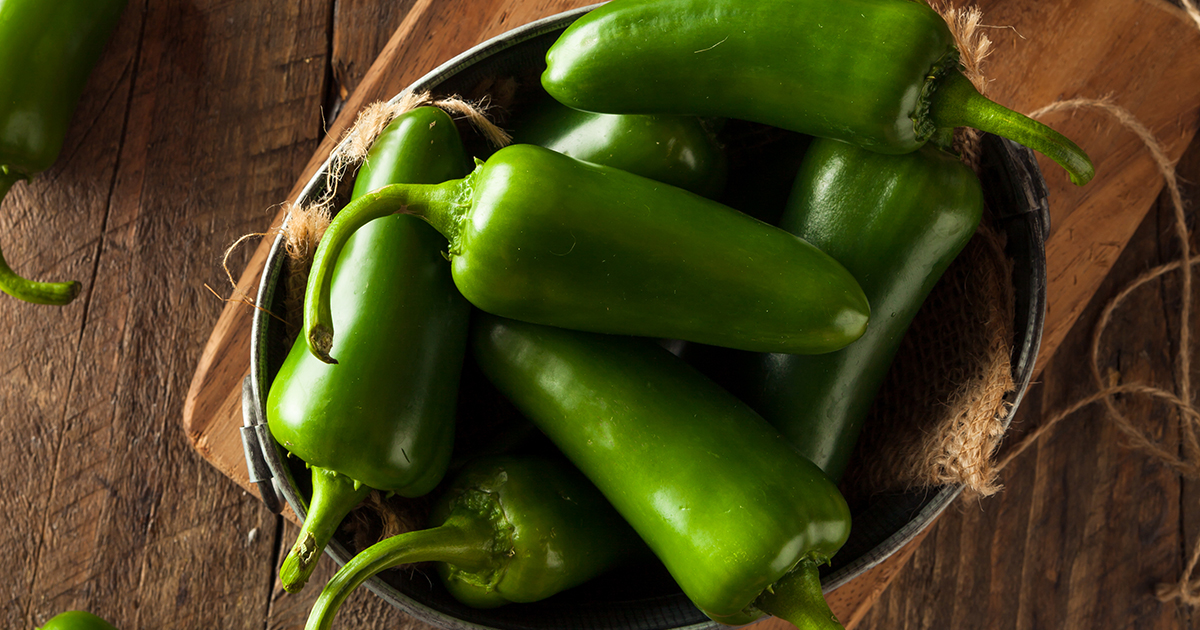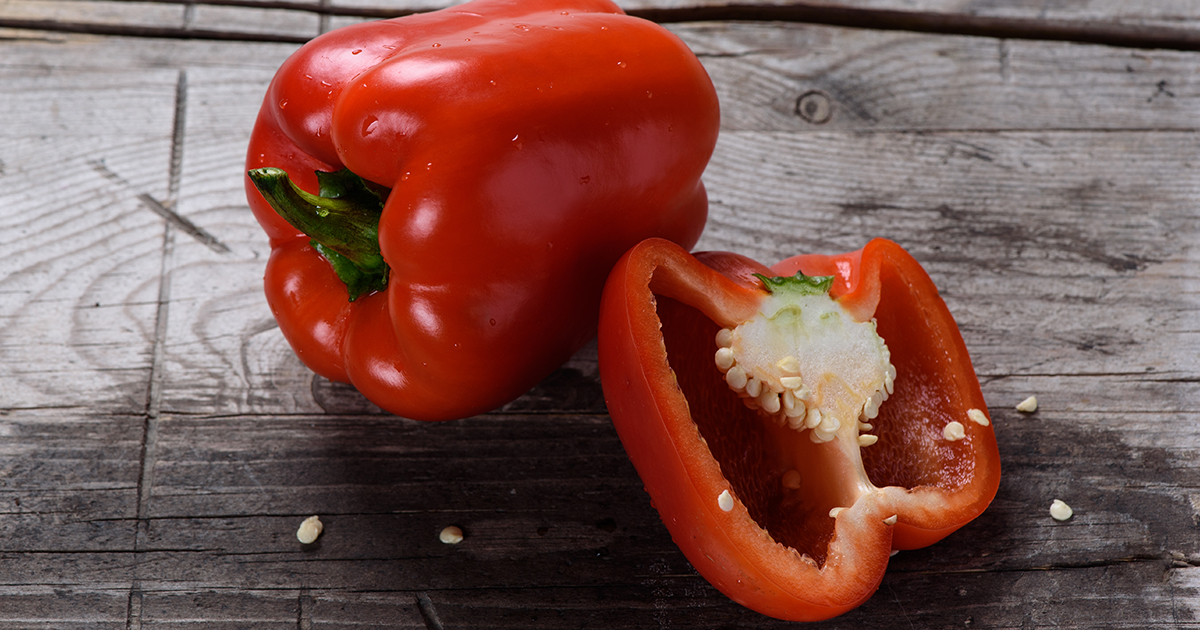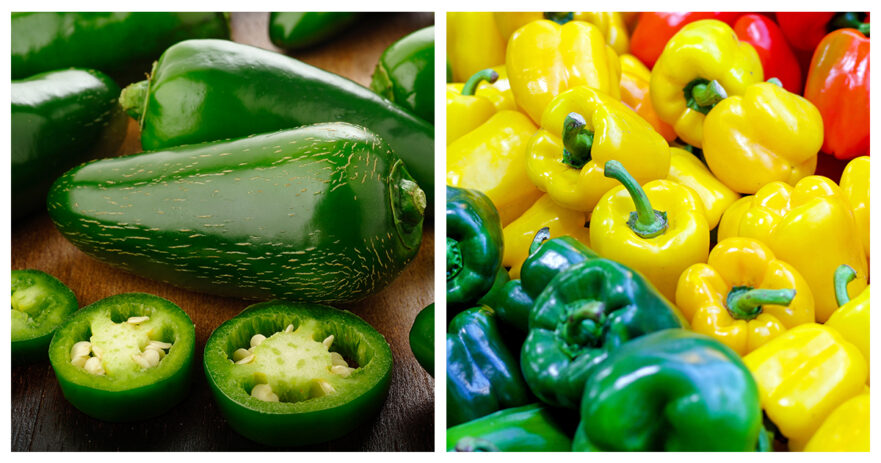Peppers have made their way to the hearts of food enthusiasts worldwide due to their ability to add flavor to dishes. Whether you want something sweet or spicy, the crazy range of flavors, colors, and heat levels make them such a fun ingredient to work with. Among the most popular kinds of peppers are jalapeños and bell peppers, which have become staple ingredients in various cuisines globally. This article aims to take you through the differences between jalapeño and bell peppers, giving you the knowledge you need to choose the best pepper for your next recipe.
| Jalapeño pepper | Bell pepper | |
| SHU | 2,500 - 8,000 | 0 - 0 |
| Median SHU | 5,250 | 0 |
| Flavor | Grassy, vegetale, slightly sweet, and moderately spicy | Sweet and mild, with no heat |
| Species | Capsicum annuum | Capsicum annuum |
| Origin | Mexico | Mexico, Central America, the Caribbean and northern South America |
| Uses | Salsas, guacamole, nachos, jalapeño poppers, etc. | Raw or cooked in a variety of dishes, salads, etc. |
Table of contents
What are Jalapeño Peppers?

Jalapeño peppers are a chili pepper that were first found in Mexico. These peppers are known for their spicy and grassy flavor, as well as their ability to work in different types of cuisines.
These little peppers are small to medium-sized, with a smooth, shiny skin that’s most often a dark green when we eat them. Jalapeños have a Scoville rating of 2,500 to 8,000, which makes them relatively mild compared to other types of chili peppers but enough to have a notable hit.
These peppers are used in plenty of dishes across all sorts of cultures. Think of foods like salsas, guacamoles, and other dips, as well as tacos, burritos, and enchiladas. They‘re also commonly used as toppings for pizzas, sandwiches, and burgers, freshly sliced or in pickled form. Jalapeños add a spicy kick to anything without overwhelming the other flavors you’ve got going on.
It‘s probably worth mentioning that the level of heat in a jalapeño can be influenced by multiple environmental factors. As an example, when and where they‘re grown can impact their spiciness, with jalapeños grown in hotter climates typically having higher heat than those grown in cooler places.
Other factors that can affect the heat level include the age of the pepper, the thickness, and the storage and preparation methods used. Additionally, things like weather and rainfall during the growing season can also have an impact on the spice levels.
What are Bell Peppers?

Bell peppers, also sometimes called sweet peppers, originated in Mexico and Central America (seeing a pattern with many of our peppers in location?). Unlike jalapeños, bell peppers aren‘t spicy at all and are in fact known for their sweet, juicy flavor. They come in a range of colors, including green, red, yellow, and orange, each having a slightly different flavor and nutrient profile.
Bell peppers are ideal for use in a huge variety of dishes, both cooked and raw. They‘re often used in stir-fries, salads, and fajitas, as well as stuffed with rice or meat and then cooked to perfection. They‘re also great as a topping for pizzas and sandwiches, as well as cooking into sauces and soups. Bell peppers add a colorful and flavorful element to any dish, and their versatility makes them a popular ingredient in many kinds of cuisines and cultures.
Bell pepper plants are pretty easy to grow, which makes them very popular among home gardeners. They do require well-draining soil and plenty of sunlight to thrive, and the plants can grow up to three and a half feet tall and produce peppers throughout the growing season. They‘re also known for their high vitamin C content, making them a nutritious and yummy addition to any meal.
What are the differences between Jalapeño and Bell Peppers?
Jalapeños and bell peppers are two immensely popular pepper varieties, each with plenty of their own unique qualities. While these peppers are similar in some ways, they look, taste, and are used in cooking very differently.
One of the most obvious differences between jalapeño and bell peppers is definitely the way that they look. Jalapeños are smaller, about two to four inches in length, and have a more tapered shape. They’re usually green, but can also turn red as they mature past the usual prime. Bell peppers, however, are usually larger and have a bell-like shape to them. You can find them in a solid range of colors, anywhere from green, red, yellow, orange, and even purple!
Another major difference between these two peppers is related to how they taste. Jalapeños are known and loved for their mid-level heat and slightly sweet flavor with just a little bit of earthiness. In contrast, bell peppers have become popular for their almost fruity flavor with no heat at all.
The different aspects of jalapeños and bell peppers make them ideal for different cooking uses. Jalapeños are often used in intentionally spicy dishes and can also be used to add some heat to things. Bell peppers, on the other hand, are super versatile and can be used in a ton of ways. They’re often used in raw dishes as well as cooked ones, from decorating salads to being stuffed and baked.
What are the similarities between Jalapeño and Bell Peppers?
While these guys have many differences, there are also some similarities between the two types of peppers. The big one is that both peppers belong to the same species, Capsicum annuum. This means they‘re both part of the same plant family, sharing many of the same characteristics.
Additionally, both jalapeños and bell peppers are extremely versatile ingredients that can be prepared in a ton of different ways. They can be sliced, diced, chopped, or stuffed and can be used in both raw and cooked dishes. You have so many options when working with either type of pepper.
Another similarity between these two is that they can be found across different culinary traditions. Both have become staples in kitchens around the world, their adaptability and unique flavors making them incredibly popular ingredients. No matter where you go in the world, chances are high that you’ll find a meal that has one of these peppers.
Both jalapeños and bell peppers are easy to find in grocery stores and at farmers’ markets almost any time of the year. This makes them an accessible ingredient for home cooks, no matter the season. They’re also affordable, making them a great option for those who are living on a budget but still want to add more fresh, flavorful ingredients into their foods.
Finally, jalapeños and bell peppers can both be just oh-so-pretty to look at in your food! Their vibrant hues and unique shapes make them useful ingredients for garnishing and decorating plates, along with being in the food itself, adding an extra element of aesthetic appeal to any meal you may be cooking.
FAQ about jalapeño and bell peppers
What are some common recipes that use jalapeño peppers?
Jalapeño peppers can be found in all kinds of things: salsa, guacamole, jalapeño poppers, chili, enchiladas, and tacos. That’s just a tiny handful of your options.
Are jalapeño peppers only grown in Mexico, or are they also grown in other parts of the world?
Jalapeño peppers are definitely grown all over the world. If it’s a warm environment, they can grow there. They’re grown in huge amounts in Mexico, though.
Can I swap out jalapeño peppers with bell peppers in recipes?
Sure, but it’ll be very different in the heat and flavor profile. If you really want a less spicy dish, then bell peppers can be a decent substitution.
How do I know if a jalapeño pepper is ripe?
Look for that beautiful green color. Also, a ripe jalapeno pepper will have smooth, slightly soft skin.
How do I store jalapeños and bell peppers to keep them fresh?
Jalapeños and bell peppers should be stored in the refrigerator in a plastic bag or container to keep them fresh. They‘ll generally keep for up to a week.
Can I freeze jalapeños or bell peppers?
Totally! Both jalapeños and bell peppers can be frozen, though it's best to remove the seeds and membranes before freezing to prevent them from becoming bitter. They can be frozen whole or sliced.

